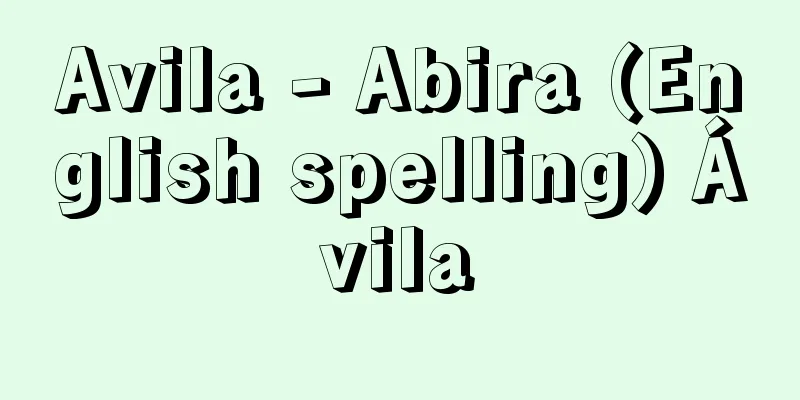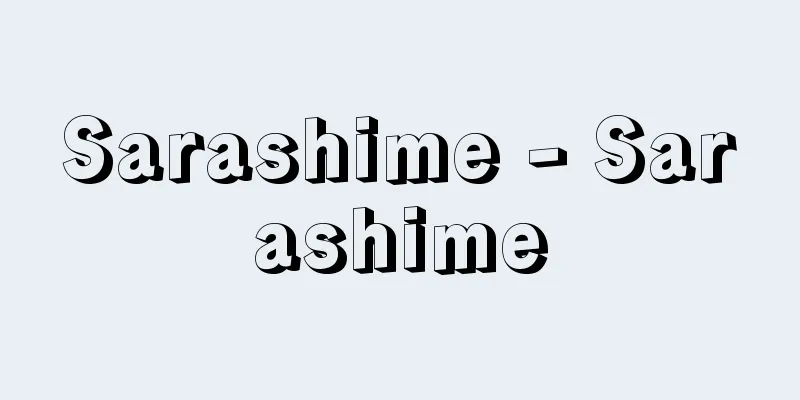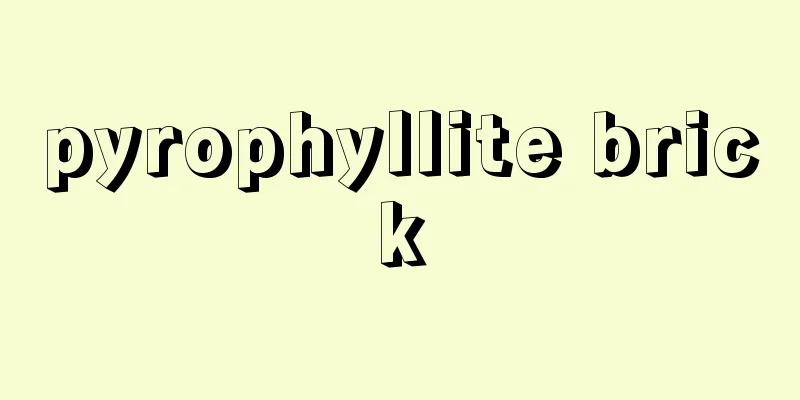Post box - Yubin Post

|
A container installed for mail delivery. It is commonly known as a post box, but its official name as defined by the Postal Act is a "mail box." [Masayoshi Kobayashi] Early PostsWhen the postal service was established in Japan in 1871 (Meiji 4), it was set up in the three capital cities of Tokyo, Kyoto, and Osaka, as well as in post towns along the Tokaido road, under the names of letter collection boxes and letter collection boxes. The establishment of post offices and post boxes, as well as the use of postage stamps, are what distinguish the modern postal system from the traditional courier system, and are part of the reason why it is called new-style postal service. The following year, in 1872, a square, pillar-shaped post box made of black wood (lacquered with chan paint) was made, and this shape came to dominate the post box scene of the Meiji era. One famous anecdote from the early days of the postal service is that a post box was mistaken for a toilet. This was the case when post boxes of this shape were marked "mail box" on the front, but this was read as "tari-bin box." In 1901 (Meiji 34), trials began on a red, cylindrical iron post box, prototyped by private citizens Tawaraya Takashichi (1854-1912) and Nakamura Koji. Based on these tests, Public Notice No. 808 of October 1908 stipulated that post boxes must be made of iron, cylindrical, and red in color. Hanging boxes, also made of iron, were also stipulated at this time. What made it different from later cylindrical iron post boxes was that the mail slot was a turntable, which revealed the mail slot when turned. The handling of airmail began in April 1929 (Showa 4), and at that time sky blue postboxes with a narrower body than regular postboxes appeared. These were called postboxes specifically for airmail, and were the forerunners of the blue express postboxes. In contrast to hanging postboxes, postboxes with a pillar shape were called "postboxes." It was in 1949 (Showa 24) that post boxes were officially named mail boxes, and they began to be numbered to distinguish between different types. Previously, they were divided into two categories: post boxes (today's pillar-shaped) that were installed on the road, and post boxes (today's box-shaped) that were hung on walls or other surfaces. The plain wood post boxes from when the post office was founded in 1871 (Meiji 4) are thought to be the prototype of these hanging boxes. In 1883, the color of the hanging boxes was sometimes changed to grass green. In 1908 (Meiji 41), the specifications for cylindrical red iron mailboxes were established, but at the time, black wooden mailboxes were still more prevalent. Around 1937 (Showa 12), the wartime regime was strengthened, and iron mailboxes were donated to make weapons and bullets. As a result, what were called "national policy mailboxes" made of concrete or ceramic began to appear, and the hanging boxes were also made of wood. It was in 1950, after the Second World War, that the cylindrical red iron mailboxes were revived in a new look. [Masayoshi Kobayashi] Modern PostWith the rapid economic growth in the 1950s and 60s, postal use began to increase rapidly, leading to improvements in post boxes and the appearance of new types of post boxes. A distinctive feature was that post boxes became square. In 1951 (Showa 26), the conventional cylindrical iron post box was improved to accommodate road conditions and re-introduced with a new type of post box that could move freely at the top and bottom, and with adjustable insertion and removal openings. This was called the No. 1 post box. In the same year, the square No. 3 post box with a larger capacity also appeared for the first time. The box-shaped post box that was hung on a wall was called the No. 2 post box. In 1959, a post box with a storage box for pre-delivery mail (No. 6 post box) and a storage room for storing mail in advance appeared, as well as a blue post box for express mail (No. 4 post box). In 1960, a large box-shaped post box (No. 5 post box) appeared, and the post box type changed from No. 1 to No. 6. This led to the establishment of the practice of calling post boxes by their numbers. In 1962, post boxes with two slots for specific destinations (No. 7 post boxes) were introduced, allowing mail to be sent to separate destinations, such as for Tokyo and other prefectures. The reason post boxes became larger and squared was because collection bags could be placed inside to make collection more efficient. Many No. 7 post boxes were built in big cities such as Tokyo and Osaka, but the following year in 1963, No. 8 post boxes were introduced for use in areas with relatively little mail being sent. In 1970, the square No. 1 postbox appeared, and along with the conventional cylindrical postbox, there were two types of No. 1 postboxes. As larger houses began to be built in the suburbs, wall-mounted postboxes became inconvenient, and No. 9 postboxes, which could be installed on the street, appeared in 1974. On September 1, 1981, Notification No. 668 announced the standard postbox styles, with 14 types of pillar-shaped and 2 types of box-shaped postboxes. Although commemorative postboxes had been erected before, this time it was decided that decorations designed for commemorative purposes could be installed on the top of regular postboxes. In December 1998, 14 new types of postboxes were developed, with a gently curved roof on the top of the conventional square postboxes to give the impression of rounded corners, and the new standard postbox styles were announced. The following year, in 1999, these new square postboxes began to appear all over the country. The number of postboxes installed across the country was approximately 173,000 at the end of fiscal 1998, and 180,774 at the end of fiscal 2018. The shape and color of postboxes are unique to each country, with colors ranging from blue, red, yellow, and green, to suit the local climate and conditions. The names for postboxes are also different in each country. In France they are called boîte aux lettres, in England they are called post boxes or letter boxes, and in America they are called mailboxes. In Germany they are called Briefkasten, and in China they are called yutong (mail tubes). [Masayoshi Kobayashi] [Reference] |Source: Shogakukan Encyclopedia Nipponica About Encyclopedia Nipponica Information | Legend |
|
郵便物を差し出すために設置された容器。ポストの名で親しまれているが、郵便法で定められた正式名称は「郵便差出箱」という。 [小林正義] 初期のポスト日本で郵便が創業された1871年(明治4)には、書状集箱(あつめばこ)、集信(しゅうしん)箱という名称で、東京、京都、大阪の3都と、東海道筋の宿場に設置された。郵便局やポストを設置したこと、郵便切手を使用したことなどが、従来の飛脚制度と近代的な郵便制度が異なる点であり、新式郵便と称された理由の一端がある。翌1872年には、木製黒色(チャン塗り)の四角い柱形のポストがつくられ、この形のものが、明治時代のポストの座を占めることになった。郵便創業当時の著名なエピソードに、ポストをトイレと間違えたという話がある。それはこの形のポストで、当時はポストの正面に「郵便箱」と表示されていたが、それを「垂便箱」と読んだのが原因であった。 1901年(明治34)には、鉄製で円筒形の赤いポストの試用が始まったが、これを試作したのは民間の俵谷高七(たわらやたかしち)(1854―1912)、中村幸治である。このテストを踏まえ、1908年10月の公達第808号によって、ポストは鉄製で円筒形、色は赤と定められた。同じく鉄製の掛形式の掛函(かけばこ)も、このとき定められている。のちの鉄製で円筒形のポストと違うところは、郵便物の差出口が回転盤となっており、この回転盤を回すと、差出口が現れる構造であった。 1929年(昭和4)4月に航空郵便の取扱いが開始され、このときに一般のポストより胴が細めの空色のポストが登場した。航空郵便専用郵便柱函(ちゅうかん)とよばれるもので、青色の速達専用ポストのいわば先駆けとなったものである。なお、掛函式のポストに対し、柱形のポストは「柱函」とよばれていた。 ポストの正式名称が郵便差出箱となったのは1949年(昭和24)で、ナンバーをつけてその種類が区別されるようになった。以前は、路上に設置する郵便柱函(現在の柱形)と、壁面などに掛けて設置する郵便掛函(現在の箱形)に2分類されていた。1871年(明治4)の郵便創業時の白木造りのポストは、この掛函の祖形と考えられる。1883年には、掛函の色が、草色となったこともあった。 1908年(明治41)に、円筒形の赤い鉄製のポストの仕様が定められたが、当時は、まだ黒い木製のポストが多かった。1937年(昭和12)ごろになると、戦時体制が強化され、武器、弾丸などをつくるため、鉄製ポストが供出された。そのため、コンクリートや陶器製の「国策ポスト」とよばれるものが登場し始め、掛函も木製となった。円筒形の赤い鉄製ポストが、新しい装いのもとに復活したのは、第二次世界大戦後の1950年である。 [小林正義] 現代のポスト昭和30年代の高度経済成長とともに、郵便の利用が急上昇し始めたため、ポストは改善され、また新種のポストも次々と出現した。特徴としては、ポストが角型化する点にあった。1951年(昭和26)には、道路事情等にあわせて、従来型円筒の鉄製ポストが改善され、胴の上部と下部が自由に動き、差出口と取出口の位置が変えられるものとして再登場した。これは1号ポストとよばれた。同年には、容量の大きい角型の3号ポストも初登場した。また壁面などにかける箱形のポストは2号ポストとよばれた。1959年に、配達する郵便物を事前に運び、保管しておく格納庫を備えた前送保管箱つきポスト(6号ポスト)と、速達専用の青色のポスト(4号ポスト)が登場した。1960年には箱形で大型(5号ポスト)が登場し、ポストの制式が1号から6号となった。これによって、ポストをナンバーでよぶことが定着した。1962年には、都内あてと他府県あてというように、あて先を分けて差し出してもらう、差出口が二つある方面別ポスト(7号ポスト)が登場した。ポストが大型化し、角型化したのは、内部に取集袋をセットして取集作業を効率化したためである。この7号ポストは、東京、大阪などの大都市に多く建てられたが、翌1963年には、郵便差出しが比較的少ない地域に設置する8号ポストが登場した。 1970年(昭和45)に、角型の1号ポストが登場し、従来からの円筒形のものとともに1号ポストとよばれるものが2種となった。郊外に大型の住宅が建設されるようになると、壁面にかける形では不都合が生じ、路上に設置できる9号ポストが1974年に登場した。1981年9月1日、告示第668号によって、ポストの制式を一括告示し、柱形14種、箱形2種とした。それ以前にも記念ポストが建てられていたが、このとき、通常ポストの上部に、記念等のためにデザインした装飾を設置できることにした。1998年(平成10)12月に、従来の角型ポスト上部の屋根に緩やかなカーブをつけ、角に丸みを感じさせる新式のポスト14種が開発され、これを加えたポストの制式が新しく告示された。翌1999年には、この新しい角型のポストが各地に登場し始めた。なお、全国各地のポストの設置数は、1998年度末で約17万3000本、2018年度末で18万0774本となっている。 ポストの形状、色彩は、各国の風土的な状況などに対応し、青、赤、黄、緑と個性的である。その名称もそれぞれに異なっている。フランスはboîte aux lettres、イギリスはpost boxあるいはletter boxといい、アメリカはmailboxとよぶ。ドイツではBriefkastenといい、中国では郵筒(ユートン)とよんでいる。 [小林正義] [参照項目] |出典 小学館 日本大百科全書(ニッポニカ)日本大百科全書(ニッポニカ)について 情報 | 凡例 |
>>: Postal Newspaper - Postal Newspaper
Recommend
Egawa Tamanori Ichiza (Egawa Tamanori Ichiza)
...The first Japanese performer to perform ball-r...
lender of last resort
...Central banks accept current account deposits ...
Fujiwara no Nakanari - Fujiwara no Nakanari
Year of death: 11th September 1st of the Kōnin per...
Moretti, R.
… At a time when talkies were in vogue and sound ...
Orekhovo‐Zuevo (English spelling)
A city in Moscow Oblast, Russian Federation, weste...
Gunmetal
〘 noun 〙 (named after its use in the manufacture o...
Trautwein, F. (English spelling) TrautweinF
...Various timbres are created by using a sound s...
Administrative hierarchy - gyoseikaikyuu
…Only the activities of senior civil servants are...
ARPA (Ships)
…Current devices are automated to a certain exten...
Tockus camurus (English spelling)
...Length is 38-125cm. The smallest species is th...
loi d'ordre public (English spelling)
...In addition, unless there is an international ...
Touch - Touch
〘noun〙 (a noun derived from the conjunctive form o...
Grasshopper - Grasshopper
An insect belonging to the family Scutellaria in ...
Zisi - Lion
A Chinese thinker and scholar from the Spring and...
browsers
…Originally, it meant only the former, but the de...








![Gregory [VII] - Gregory](/upload/images/67cb71b249b34.webp)
